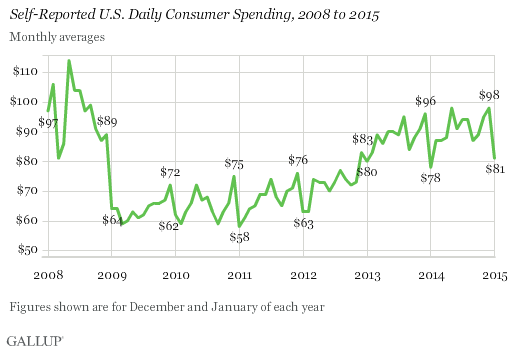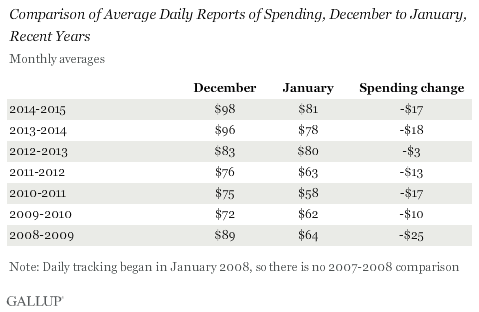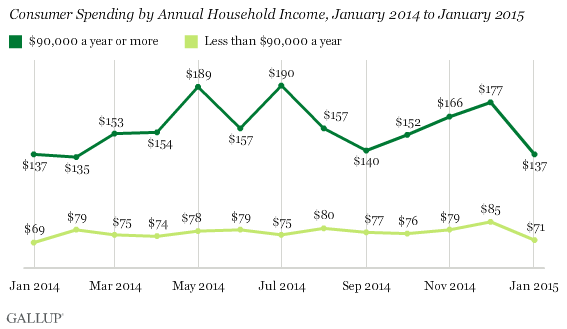Story Highlights
- Average spending fell $17 from December to January to $81
- Spending typically falls between December and January
- Despite drop, January spending was one of highest since 2008
WASHINGTON, D.C. -- U.S. consumers' daily self-reports of spending fell to an average of $81 in January, down from $98 in December. Spending usually drops after the holiday season, falling an average of $15 each January since 2008. Despite this year's $17 drop, $81 is one of the highest self-reported averages in any January since 2008.

The January 2015 average is based on Gallup Daily tracking interviews with 14,721 U.S. adults. Gallup asks Americans to estimate the total amount they spent "yesterday" in restaurants, gas stations, stores or online -- not counting home and vehicle purchases, or normal monthly bills -- to provide an indication of Americans' discretionary spending.
December daily spending averages are often among the highest of the year because of holiday shopping. The drop in January is largely attributable to less shopping and gift buying after the holidays. However, comparing January 2015 with past Januaries can indicate how comfortable Americans feel with their finances and the level of discretionary money they have. That the daily average in January 2015 is the one of the highest since January 2008 is a good sign for the economy, and helps reinforce other positive economic measures, such as increased job creation and growing economic confidence.

Spending Drops Among Upper- and Lower-Income Americans
Average daily spending fell among upper- and lower-income Americans in January. However, spending dropped more, $40, among the upper-income group (those making at least $90,000 a year) than among the lower-income group (those making less than $90,000), $14.

The $40 drop among upper-income Americans is the largest monthly decline seen since January 2011. Among lower-income Americans, the $14 drop is the largest since January 2014. Last month, upper-income Americans reported spending an average of $137 per day, compared with $71 per day among lower-income Americans.
Upper-income Americans, who usually have more disposable income, typically spend more per month than lower-income Americans do. And upper-income Americans' average spending is more likely to vary month to month than lower-income Americans' spending. However, lower-income Americans make up the bulk of U.S. consumers.
Implications
While a drop in reported spending is not usually a good sign for the U.S. economy, it is common and expected in January. Therefore, last month's drop is not especially troubling, especially because it is in line with prior January drops, and because the current monthly average remains well above what Gallup measured from 2009 to 2012.
Low gas prices could leave Americans with more money to spend in other places, although it is not clear whether the drop in gas prices affects net spending. Americans may just use the money they would have spent on one type of purchase (gas) on another (such as retail). Consumers ended 2014 on a strong note, with the Commerce Department on Friday indicating that robust spending drove an estimated 2.6% increase in the U.S. gross domestic product in the fourth quarter.
Survey Methods
Results for this Gallup poll are based on telephone interviews conducted Jan. 2-31, 2015, on the Gallup U.S. Daily survey, with a random sample of 14,721 adults, aged 18 and older, living in all 50 U.S. states and the District of Columbia. For results based on the total sample of national adults, the margin of sampling error is ±1 percentage point at the 95% confidence level. The margin of error for the spending mean is ±$4. All reported margins of sampling error include computed design effects for weighting.
Each sample of national adults includes a minimum quota of 50% cellphone respondents and 50% landline respondents, with additional minimum quotas by time zone within region. Landline and cellular telephone numbers are selected using random-digit-dial methods.
Learn more about how the Gallup U.S. Daily works.

